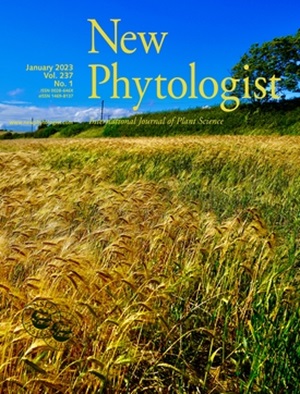Phylostratigraphic analysis revealed that ancient ohnologue PtoWRKY53 innovated a vascular transcription regulatory network in Populus.
IF 8.3
1区 生物学
Q1 PLANT SCIENCES
引用次数: 0
Abstract
The secondary vascular system represents a hallmark innovation in woody plant evolution. While contemporary studies have decoded key molecular networks governing its development, the evolutionary trajectory of these regulatory systems remains elusive. We performed integrated phylostratigraphic and transcriptomic profiling across six Populus species spanning five phylogenetic clades to decipher the evolutionary dynamics of regulatory genes in the secondary vascular system. This analysis revealed that over 51% of regulatory genes originated from the most ancient phylostratum (PS1). The observed 65% gene expansion in the PS1 was driven by whole-genome duplication (WGD). Through phylotranscriptomic and gene co-expression network analysis, we found that dosage-unconstrained ohnologues from three PS1 families, MYB domain protein, NAC domain containing protein, and WRKY DNA-binding protein, have significant xylem-specific expression. We identified an ohnologue, PtoWRKY53, which forms a new transcription regulatory network in xylem via neofunctionalization. Transgenic analyses revealed that PtoWRKY53 transcriptionally represses PtoCESA3, thereby inhibiting xylem secondary wall biosynthesis and reducing poplar height (26.39%) and stem diameter (18.36%). Our study highlights the importance of interactions between ancient genes and WGD in generating morphological innovations of the secondary vasculature in Populus.系统地层分析表明,古同源基因PtoWRKY53在杨树中形成了一个维管转录调控网络。
次生维管系统是木本植物进化过程中一个标志性的创新。虽然当代研究已经解码了控制其发展的关键分子网络,但这些调节系统的进化轨迹仍然难以捉摸。我们对跨越5个系统发育支系的6种杨树进行了系统地层学和转录组学综合分析,以破译次生维管系统中调控基因的进化动力学。分析表明,超过51%的调控基因来自最古老的系统层(PS1)。PS1中65%的基因扩增是由全基因组重复(WGD)驱动的。通过系统转录组学和基因共表达网络分析,我们发现三个PS1家族的无剂量同源物MYB结构域蛋白、含NAC结构域蛋白和WRKY dna结合蛋白具有显著的木质部特异性表达。我们发现了一个同源物,PtoWRKY53,它通过新功能化在木质部形成一个新的转录调控网络。转基因分析显示,PtoWRKY53转录抑制PtoCESA3,从而抑制木质部次生壁的生物合成,降低杨树高度(26.39%)和茎粗(18.36%)。我们的研究强调了古代基因和WGD之间的相互作用在杨树次生脉管系统形态创新中的重要性。
本文章由计算机程序翻译,如有差异,请以英文原文为准。
求助全文
约1分钟内获得全文
求助全文
来源期刊

New Phytologist
生物-植物科学
自引率
5.30%
发文量
728
期刊介绍:
New Phytologist is an international electronic journal published 24 times a year. It is owned by the New Phytologist Foundation, a non-profit-making charitable organization dedicated to promoting plant science. The journal publishes excellent, novel, rigorous, and timely research and scholarship in plant science and its applications. The articles cover topics in five sections: Physiology & Development, Environment, Interaction, Evolution, and Transformative Plant Biotechnology. These sections encompass intracellular processes, global environmental change, and encourage cross-disciplinary approaches. The journal recognizes the use of techniques from molecular and cell biology, functional genomics, modeling, and system-based approaches in plant science. Abstracting and Indexing Information for New Phytologist includes Academic Search, AgBiotech News & Information, Agroforestry Abstracts, Biochemistry & Biophysics Citation Index, Botanical Pesticides, CAB Abstracts®, Environment Index, Global Health, and Plant Breeding Abstracts, and others.
 求助内容:
求助内容: 应助结果提醒方式:
应助结果提醒方式:


